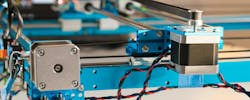In factory automation systems, there are a variety of different motor technologies used for different applications, depending on the demands required of the motor, system costs or interaction with other motion system components, such as coordinated motion. The types of motors typically encountered in the factory include synchronous or induction AC (alternating current) motors, DC (direct current) motors, both brushed and brushless, and permanent magnet motors. The stepper motor has been around for over a century, but has been gaining increased attention, new advancements and increased application in the last 10 years or so.
Stepper motors are crucial components in modern manufacturing and automation industries, offering precise control and reliability in a wide array of applications. Understanding how these motors function, their diverse uses and recent technological advancements provides insight into their pivotal role in manufacturing technology.
Stepper motors are synchronous motors with a high number of poles. At their core, they convert electrical pulses into precise mechanical movements. Unlike traditional electric motors that spin continuously when voltage is applied, stepper motors move in discrete steps. This characteristic makes them ideal for applications requiring precise positioning, such as robotics, 3D printers, computer numerical control (CNC) machines and automated assembly lines.
Control of stepper motors is achieved through a driver circuit that sequences the energization of the coils based on input pulses from a controller, often a microcontroller or programmable logic controller (PLC). The number of steps per revolution (step angle) and the torque output depend on the motor's construction and the drive electronics' capabilities.
The advantages of stepper motors include high holding torque and very good positioning ability. By intelligently controlling the stator windings in full or micro-step mode, individual steps or partial steps can be driven to without position feedback (open-loop control). This distinguishes stepper motors from servo motors and makes them a cost-effective alternative. However, excessive acceleration and fast load cycles can result in the stepper motor no longer being able to follow the rotary field and "lose steps." The encoder option can improve matters in this situation.
Over the past ten years or so, several advancements have significantly enhanced stepper motor technology, broadening their capabilities and applications beyond the first 90 years of their existence. Some of these advancements include:
- Integration with digital control systems: The integration of stepper motors with advanced digital control systems, such as microcontrollers and field-programmable gate arrays (FPGAs), has improved their precision and reliability. Digital control allows for smoother motion profiles, less noise and more efficient current regulation, reducing heat generation and improving motor lifespan.
- High-torque designs: Advances in magnet and rotor design have led to stepper motors capable of delivering higher torque outputs in smaller form factors. This enhancement is particularly beneficial in applications requiring compact and powerful motors.
- Closed-loop control: Traditionally, stepper motors operated in open-loop systems, relying solely on step commands without feedback on actual position. Recently, closed-loop control systems have become more prevalent, incorporating position feedback, usually through internal or external encoders, to correct for missed steps or external disturbances. This advancement significantly improves accuracy and reliability in demanding applications.
- Energy efficiency: Efforts to improve energy efficiency have led to the development of stepper motors that operate at lower power consumption while maintaining high performance. This is critical in applications where minimizing energy use is a priority, such as battery-powered devices and green manufacturing initiatives.
- Customization and modularity: Manufacturers now offer stepper motors with greater customization options, allowing engineers to select motors tailored to specific torque, speed and size requirements. Modular designs facilitate easier integration into diverse systems, accelerating development cycles and reducing time to market for new products.
- Advanced materials and manufacturing techniques: Innovations in materials science and manufacturing processes have enabled the production of stepper motors with enhanced durability, heat dissipation capabilities and resistance to environmental factors such as moisture and dust. These improvements contribute to longer operational lifespans and reduced maintenance requirements.
Stepper motors continue to evolve as indispensable components in manufacturing and automation, driven by ongoing advancements in control technology, materials science and design innovation. Their ability to provide precise motion control makes them essential in applications ranging from industrial machinery to consumer electronics. Looking ahead, further improvements in efficiency, integration with digital control systems, and specialized applications are expected to increase their place as both foundational elements of modern automation solutions, and a complementary technology to servo systems. As industries continue to demand higher levels of performance and reliability at lower cost, complexity and power consumption, stepper motors will undoubtedly play a pivotal role in shaping the future of automated systems worldwide.
About the Author

Joey Stubbs
contributing editor
Joey Stubbs is a former Navy nuclear technician, holds a BSEE from the University of South Carolina, was a development engineer in the fiber optics industry and is the former head of the EtherCAT Technology group in North America.
Sign up for our eNewsletters
Get the latest news and updates

Leaders relevant to this article:
